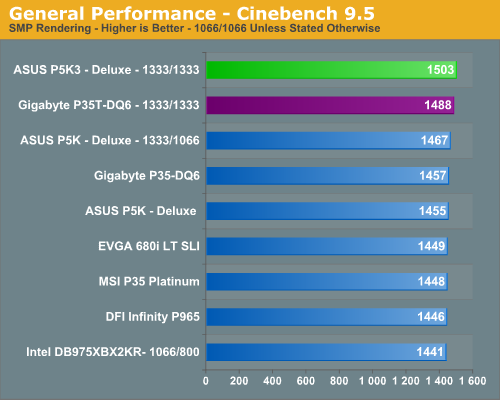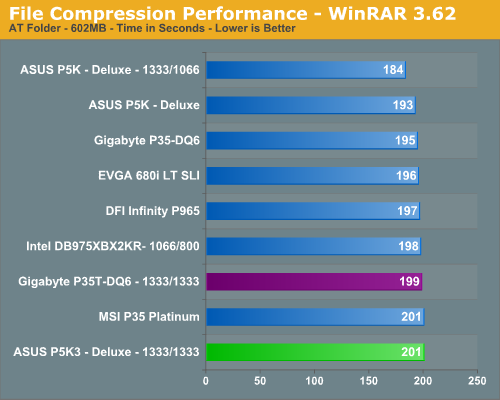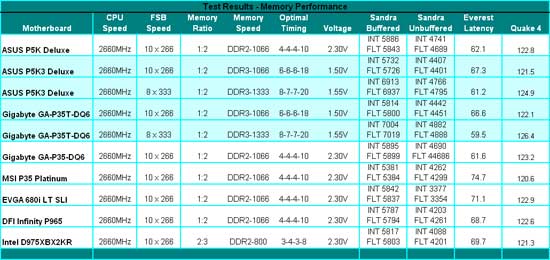Gigabyte GA-P35T-DQ6: DDR3 comes a knocking, again
by Gary Key on May 30, 2007 2:00 AM EST- Posted in
- Motherboards
Memory Performance
We optimized each BIOS to provide the best performance at similar memory timings while still being able to complete our entire benchmark test suite. We will fully optimize each board based upon its best performance potential in our upcoming chipset shootout. However, for now we are comparing like timings on each board to show differences in the way each manufacturer implements other BIOS enhancements such as ASUS's Transaction Booster or Gigabyte's Turbo Memory enhancement. Despite the cliché names, we generally see an improvement in unbuffered memory and latency results of up to 7% when they are enabled.
Gigabyte's latest F2N BIOS has brought their DDR3 memory performance up to and it is now surpassing ASUS's DDR3 performance. We expect MSI to improve their memory performance greatly in a soon to be released performance BIOS. In the meantime, we notice that DDR3-1066 memory performance is just not worth the price of admission. In fact, we cannot recommend anything less than DDR3-1333 if you are considering a DDR3 board. The performance penalties are just too severe as our original P35 chipset preview article showed. In fact, we have removed DDR3-1066 scores from our results now. Stay away; stay far away. (DDR3-1066 reminds us a bit of DDR2-400, and we expect it to have a similar shelf life.)
We see our Gigabyte P35T-DQ6 offering the best overall memory bandwidth, latency, and Quake 4 scores in our tests. The price for this is a seeming lack of ability for this board to run DDR3 past 1600MHz with our QX6700 in a stable manner. Whether this is the BIOS, our early DDR3 samples, or chipset issues is up for debate at this point. What we do know is our ASUS P5K3 board will run up to DDR3-1800 with the same memory and that Gigabyte is currently working to address our problem.
Rendering Performance
We are using the Cinebench 9.5 benchmark as it tends to heavily stress the CPU and FSB subsystems while performing graphics modeling and rendering. Cinebench 9.5 features two different benchmarks with one test utilizing a single core and the second test showcasing the power of multiple cores in rendering the benchmark image. We utilize the standard multiple core benchmark demo and default settings.

The improved CPU throughput speeds of the P5K3 board results in the top score, putting it 1% ahead of the Gigabyte DDR3 board. We will see this pattern continue in a couple of benchmarks that are CPU limited as the ASUS board has better CPU throughput. The remaining boards are all clustered within 2% of each other, with most of the P35 boards placing ahead of the incumbents. This is one benchmark that clearly benefits from improved front side bus speeds and memory bandwidth.
File Compression Performance
In order to save space on our hard drives and ensure we had another CPU crunching utility, we will be reporting our file compression results with the latest version of WinRAR that fully supports multi-treaded operations and should be of particular interest for those users with dual core or multi-processor systems. Our series of file compression tests utilizes WinRAR 3.62 to compress our test folder that contains 444 files, ten subfolders, and 602MB worth of data. All default settings are utilized in WinRAR along with our hard drive being defragmented before each test.

Our 1333FSB/DDR2-1066 platform provides the top score and actually distances itself from the other boards in this CPU intensive test that heavily relies on memory throughput and latency for improved performance. We see the DDR3 configurations finishing last, as it trail DDR2 right now in terms of latencies. The nature of file compression is such that memory is accessed almost constantly in a very random fashion, so page misses requiring additional time as memory bank swapping is a common occurrence.
 |
| Click to enlarge |
We optimized each BIOS to provide the best performance at similar memory timings while still being able to complete our entire benchmark test suite. We will fully optimize each board based upon its best performance potential in our upcoming chipset shootout. However, for now we are comparing like timings on each board to show differences in the way each manufacturer implements other BIOS enhancements such as ASUS's Transaction Booster or Gigabyte's Turbo Memory enhancement. Despite the cliché names, we generally see an improvement in unbuffered memory and latency results of up to 7% when they are enabled.
Gigabyte's latest F2N BIOS has brought their DDR3 memory performance up to and it is now surpassing ASUS's DDR3 performance. We expect MSI to improve their memory performance greatly in a soon to be released performance BIOS. In the meantime, we notice that DDR3-1066 memory performance is just not worth the price of admission. In fact, we cannot recommend anything less than DDR3-1333 if you are considering a DDR3 board. The performance penalties are just too severe as our original P35 chipset preview article showed. In fact, we have removed DDR3-1066 scores from our results now. Stay away; stay far away. (DDR3-1066 reminds us a bit of DDR2-400, and we expect it to have a similar shelf life.)
We see our Gigabyte P35T-DQ6 offering the best overall memory bandwidth, latency, and Quake 4 scores in our tests. The price for this is a seeming lack of ability for this board to run DDR3 past 1600MHz with our QX6700 in a stable manner. Whether this is the BIOS, our early DDR3 samples, or chipset issues is up for debate at this point. What we do know is our ASUS P5K3 board will run up to DDR3-1800 with the same memory and that Gigabyte is currently working to address our problem.
Rendering Performance
We are using the Cinebench 9.5 benchmark as it tends to heavily stress the CPU and FSB subsystems while performing graphics modeling and rendering. Cinebench 9.5 features two different benchmarks with one test utilizing a single core and the second test showcasing the power of multiple cores in rendering the benchmark image. We utilize the standard multiple core benchmark demo and default settings.

The improved CPU throughput speeds of the P5K3 board results in the top score, putting it 1% ahead of the Gigabyte DDR3 board. We will see this pattern continue in a couple of benchmarks that are CPU limited as the ASUS board has better CPU throughput. The remaining boards are all clustered within 2% of each other, with most of the P35 boards placing ahead of the incumbents. This is one benchmark that clearly benefits from improved front side bus speeds and memory bandwidth.
File Compression Performance
In order to save space on our hard drives and ensure we had another CPU crunching utility, we will be reporting our file compression results with the latest version of WinRAR that fully supports multi-treaded operations and should be of particular interest for those users with dual core or multi-processor systems. Our series of file compression tests utilizes WinRAR 3.62 to compress our test folder that contains 444 files, ten subfolders, and 602MB worth of data. All default settings are utilized in WinRAR along with our hard drive being defragmented before each test.

Our 1333FSB/DDR2-1066 platform provides the top score and actually distances itself from the other boards in this CPU intensive test that heavily relies on memory throughput and latency for improved performance. We see the DDR3 configurations finishing last, as it trail DDR2 right now in terms of latencies. The nature of file compression is such that memory is accessed almost constantly in a very random fashion, so page misses requiring additional time as memory bank swapping is a common occurrence.










22 Comments
View All Comments
SirJoe - Saturday, June 2, 2007 - link
this is cool for you computer buffsGooger - Saturday, June 2, 2007 - link
I just did a google search for XMS3 and the only merchant to have it in stock at the bargain price of $599 is Tiger Direct! Yikes, I think I will wait a while untill the price of DDR3 becomes competitive with DDR2.AdamK47 - Wednesday, May 30, 2007 - link
Sorry Gigabyte, I just can't see myself ever buying a board with pink memory slots. Shoulda stuck with the blue.Stele - Friday, June 1, 2007 - link
"Pink it's my new obsessionPink it's not even a question..."
:D Sorry, couldn't resist the temptation :P
yacoub - Wednesday, May 30, 2007 - link
Thank you especially for the note about larger heatsinks being very difficult to mount and the associated image of the back of the motherboard so folks can see what they face if they have a heatsink that requires connecting a backing plate (as most of the larger ones do).yyrkoon - Wednesday, May 30, 2007 - link
What annoys me, is that every Gigabyte motherbord review has this same 'annoyance' written in. Come now fellas, you can only say it about 500 times, beore it starts getting old, and how hard is it really to press two keys in combination ? Gigabyte obviously is doing this for a reason, and if it takes me writting this comment to point that out, well, I just dont know . . .
Saying something like: 'You will need to press cntl + F1 to access the 'protected' portion of the BIOS . . .' Would sounds less critical, would not come off as negativity, and would keep you guys from sounding lazy . . .
TA152H - Wednesday, May 30, 2007 - link
It's not hitting the keys that is the problem, it's remembering to do it. When you have loads of computers with motherboards, it's nice if they have a standard way to access features, instead of adding an inane key sequence like CTRL-F1. It is annoying, because four years down the road if you have to work on this motherboard, for whatever reason, you have to try to remember this bizarre and otherwise trivial detail. Standards are nice, especially when following them doesn't involve a tradeoff.yyrkoon - Thursday, May 31, 2007 - link
Yeah, well I personally have a bad memory, but after reading countless Gigabyte motherboard reviews from AT here, I do not think I will ever forget this key combination.Anyhow, this is one reason why when given the chance I always opt for ABIT boards, while other may opt for Asus, Gigabyte, whatever. Once you become used to a given OEM BIOS Layout, it is hard to make a change in OEMs without suffering a bit in the knowledge department(at least temporarily).
*yyrkoon hugs his NF-M2 nView . . .
TA152H - Saturday, June 2, 2007 - link
Keep in mind, not everyone buying a motherboard from Gigabyte is going to be reading these articles, and proper journalism dictates they don't depend on people knowing every previous article, so they appropriately bring it up. Before you remark what's the point in them mentioning it for people that don't read it, it's certainly going to be read by Gigabyte and by complaining enough times, they may take notice.I agree that it is often best to just buy from one maker, or limit the number. Unfortunately, I'm an idiot and I end up with stuff from too many makers. I try to buy only Intel and Supermicro, but they are too expensive sometimes, so I've ended up buying a lot of Taiwanese junk before finally finding a company from there I have had success with (don't ask me why, but Epox seems to work best for me). So, I've got all this Asus, Soyo, Aopen, MSI, Gigabyte, Tyan and a few I don't even remember running and it's difficult to deal with all the different BIOS settings when they get cute and try to be different. On the plus side, these motherboards tend to break pretty regularly so I have less and less of the inferior brands. Well, except for Epox. I have no idea why these things never break on me, but I have a feeling it's just random luck :P .
Frumious1 - Wednesday, May 30, 2007 - link
I won't forget, but I'm still annoyed by this, just like I'm annoyed by a BIOS that moves certain features into odd areas. I hate that there are about 20 ways to manage memory timings, voltages, bus speeds, etc. (and that's just picking either an AMD or an Intel platform). What's really stupid about Gigabyte's method of hiding settings is that it's not even all of the settings that get hidden. The major area lately that doesn't show up is memory timings. You can tweak voltages and fry your RAM, but GOD FORBID you play with memory timings! (There are some other things that get hidden as well, but I don't recall exactly what. I base this off my DS3 system.)